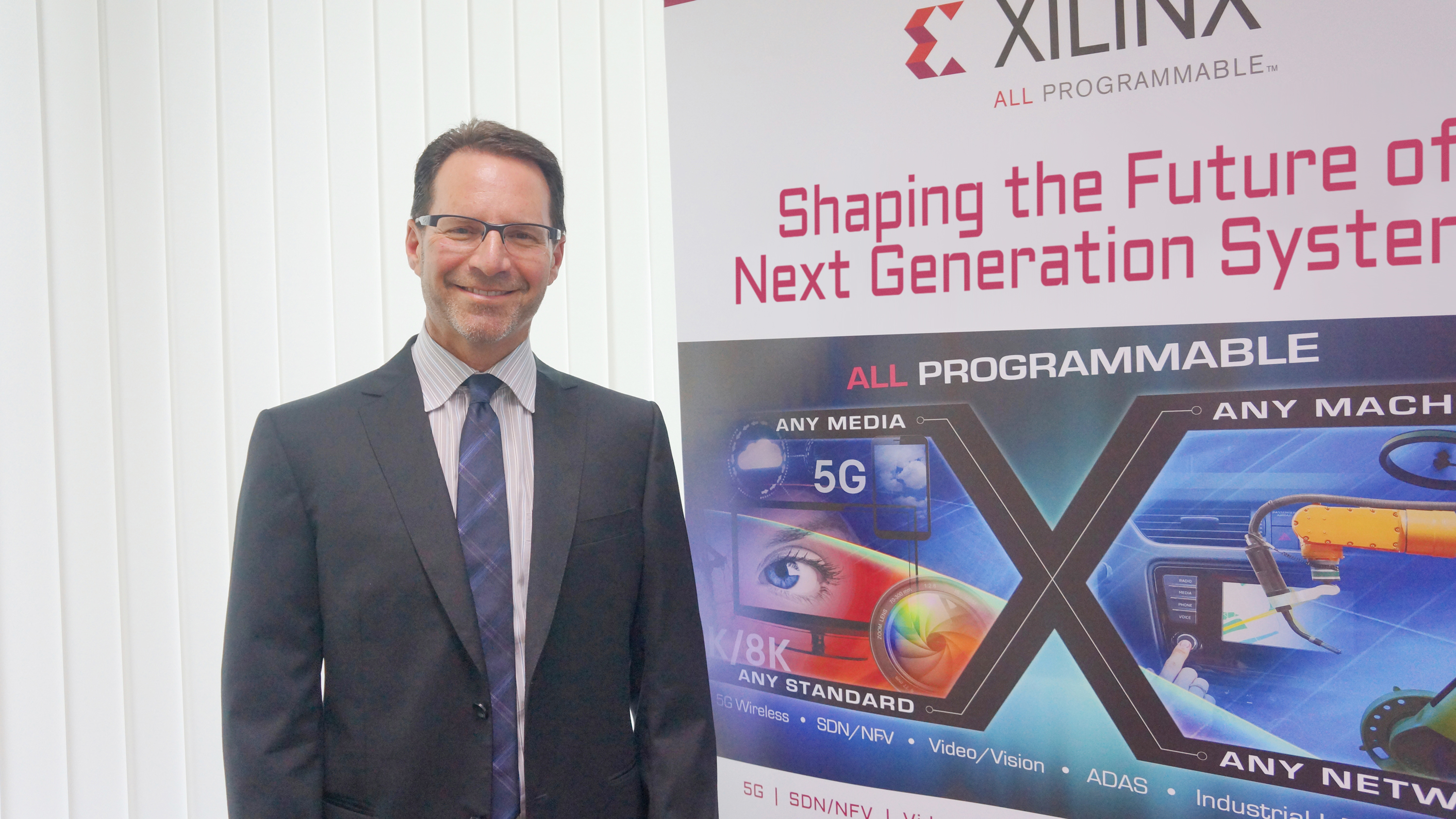새로운 세대의 소프트웨어 개발 환경을 개발하는 것은 저희의 전략 중 일부로서, 작년에 세 가지 제품을 새로 선보인 것도 바로 그러한 노력의 일환이었습니다. 또 하나 말씀 드릴 수 있는 저희의 목표는 전세계의 거대한 오픈소스 에코시스템을 이용하는 것입니다. 수많은 사람들이 개방 표준을 기반으로 하는 이 소프트웨어 정의 시스템을 위한 라이브러리와 빌딩블록을 개발하고 있습니다. 따라서 저희는 고객들이 그 모든 풍부한 오픈소스 커뮤니티와 오픈소스 자원들을 이용할 수 있도록 하고자 노력하고 있습니다. 바로 이런 방법을 통해서 기대 이상의 이점을 제공할 수 있습니다. 오픈소스 커뮤니티들은 온갖 종류의 애플리케이션을 위한 온갖 종류의 미들웨어를 구축하고 있으며, 저희는 그 모든 자원들을 이용할 수 있는 것입니다.

'올 프로그래머블' 자일링스가 정의하는 미래 전략과 목표
자일링스가 '올 프로그래머블' 업체임을 천명하며 새로운 기업 전략 방향과 향후의 목표를 발표했다.
자일링스의 기업전략마케팅 그룹 수석 부사장인 스티브 글레이저(Steve Glaser) 씨는 지난 5년간 집중적으로 추구해온 '올 프로그래머블'의 비전이 2015년에 이르러 중요한 이정표에 이르렀다고 평가하면서, 이제 자일링스는 'FPGA 업체'라는 낡은 껍질을 완전히 벗어 던지고 '올 프로그래머블'이라는 갑옷으로 무장했다고 말한다.
본지에서는 먼저 자일링스의 기업 전략에 대한 설명과 관련하여 향후 예상되는 비용과 보안 기능 로드맵에 대한 몇 가지 질문에 대한 인터뷰를 자일링스의 기업전략마케팅 그룹 수석 부사장인 스티브 글레이저(Steve Glaser) 씨로부터 들어보았다.
e4ds: 향후 자일링스의 시장 규모가 다섯 배로 늘어나도 실질적인 시장 수익은 두 배 정도가 될 것이라고 하셨는데, 비용 증가는 어느 정도가 될 것으로 예상하십니까? 예를 들어서, 시장이 다섯 배 규모로 커진다면 그 같은 시장 성장에 대응하기 위한 지원, AS, 연구 등의 비용 증가는 어느 정도가 될 것으로 예상됩니까?
Steve Glaser: 다행히도 저희가 갖고 있는 프로그래머빌러티 모델은 엄청난 이점을 갖고 있습니다. 서로 다른 수많은 사람들이 이용할 수 있는 제품을 개발할 수 있으므로 소프트웨어 정의 프로그래머빌러티에 대한 투자를 늘림에 따라 잠재적인 사용자 수는 5배로 늘어날 것으로 예상되지만, 실리콘에 대한 투자 면에서 본다면 사용자 일인당 비용 증가분은 사실상 줄어들 것입니다. 소프트웨어 환경에 대한 비교적 적은 투자로도 저희 실리콘 기술의 투자수익(RoI)은 사실상 향상될 수 있습니다. 보다 많은 사용자들이 이를 이용할 수 있기 때문입니다. 이것은 프로그래머빌러티의 관점에서 자일링스와 저희 사용자들 모두에게 매우 긍정적인 방향이라고 봅니다.
e4ds: 현재의 보유 자원을 가지고도, 혹은 이를 약간만 늘리는 정도로도 그것이 가능합니까?
Steve Glaser: 비용을 자세히 밝힐 수는 없지만, 새로운 세대의 소프트웨어 개발 환경을 개발하는 것은 저희의 전략 중 일부로서, 작년에 세 가지 제품을 새로 선보인 것도 바로 그러한 노력의 일환이었습니다. 또 하나 말씀 드릴 수 있는 저희의 목표는 전세계의 거대한 오픈소스 에코시스템을 이용하는 것입니다. 수많은 사람들이 개방 표준을 기반으로 하는 이 소프트웨어 정의 시스템을 위한 라이브러리와 빌딩블록을 개발하고 있습니다. 따라서 저희는 고객들이 그 모든 풍부한 오픈소스 커뮤니티와 오픈소스 자원들을 이용할 수 있도록 하고자 노력하고 있습니다. 바로 이런 방법을 통해서 기대 이상의 이점을 제공할 수 있습니다. 오픈소스 커뮤니티들은 온갖 종류의 애플리케이션을 위한 온갖 종류의 미들웨어를 구축하고 있으며, 저희는 그 모든 자원들을 이용할 수 있는 것입니다.
e4ds: 스마트 비용이라고 할 수 있겠군요.
Steve Glaser: 네, 저희는 다음 단계에서 그 같은 일을 달성하기 위한 매우 훌륭한 계획을 갖고 있습니다.
e4ds: 다음은 약간 먼 미래에 대한 질문을 드리고자 합니다. 오늘날에는 어떤 한 개인이 모든 것을 다 이해할 수 없으므로 전체를 모르더라도 개발에 참여할 수 있는 개발환경이 점점 더 중요해지지 않을까 생각합니다. 현재 자일링스는 소프트웨어 엔지니어들이 FPGA의 프로그램에 참여할 수 있도록 개발환경을 마련하고 있는데, 향후에는 예를 들어 소프트웨어 엔지니어가 아니라 마케팅 등의 다른 지원부서에서도 이러한 소프트웨어 개발환경에 보다 적극적으로 참여할 수 있는 툴을 개발할 로드맵 같은 것이 있습니까?
Steve Glaser: 말씀하신 분야와 같은 마케팅 및 기술 요건들에 대한 서비스는 그 분야에 집중하고 있는 다른 업체들이 제공해야 할 것입니다. IBM사의 Rational DOORS와 같은 제품들도 있고, 요건 계획(requirement planning) 및 추적성(traceability) 툴을 공급하는 다른 벤더들도 있습니다. 그 같은 종류의 제품 개발에 뛰어들 계획은 없지만, 저희는 그러한 업체들과 협력하여 고객들이 그러한 툴을 사용하기 위해 필요로 하는 모든 것을 제공할 것입니다. 소프트웨어 정의 개발 환경은 물론, 고객들이 원한다면 저희 개발 환경들이 그러한 요건관리 툴들과 호환성을 가질 수 있도록 고객들이 요구하는 모든 것을 제공할 것입니다.
e4ds: 모든 것은 고객들에게 달려 있다는 말씀이로군요?
Steve Glaser: 바로 그렇습니다. 저희가 다루는 영역은 하드웨어 및 소프트웨어 툴까지입니다. 물론 저희는 통합에 투자하고 있습니다. IP 통합을 넘어서서 소프트웨어와 하드웨어 도메인의 간극을 메우고 모든 종류의 소프트웨어 및 하드웨어 IP들을 보다 효과적으로 통합시키도록 도와주는 보다 생산적인 시스템 수준의 통합 툴들을 지향할 것입니다. 그것이 저희의 분명한 로드맵 중 일부입니다. 그러나 예컨대 마케팅 분야 스탭들을 위한 요건관리 툴은 여기에 포함되어 있지 않습니다.
e4ds: 알겠습니다. 보안 문제가 갈수록 더 복잡해짐에 따라 많은 소프트웨어 엔지니어들의 능력 범위를 벗어나고 있는 것 같습니다. 물리적 수준에서의 보안 기능 구현에 대해서 언급하셨는데, 미래에는 보안 기술에 대한 지식이 전무한 소프트웨어 엔지니어라도 귀사의 툴을 이용해서 물리적인 보안 기능들을 대부분 구현할 수 있을까요?
Steve Glaser: 그것은 저희가 앞으로 해결해 나가야 할 문제입니다. 저희의 Zinq MPSoC는 소프트웨어 및 하드웨어 양쪽과 관련된 수많은 수준의 보안 기능들을 갖추고 있으며, 보안 기능이 프로세서에 내장되어 있어 새로운 Zinq 제품군의 보안 서브시스템 및 관리 기능을 다룹니다. 따라서 저희는 고객들이 이를 사용하기가 가능한 한 쉽게 만들어야 합니다. 향후의 저희 목표는 그 같은 기능의 일부를 기본적인 하드웨어 플랫폼에 내장함으로써 소프트웨어 엔지니어가 새로운 소프트웨어 환경을 사용할 수 있도록 하는 것입니다. 소프트웨어 엔지니어가 SDx 환경을 이용하여 핵심 기능들을 프로그램하고, 플랫폼 개발을 위한 보안 기능들을 구축할 수 있도록 해야 합니다. 따라서 저희는 하드웨어 개발과 플랫폼 개발 그리고 플랫폼 프로그래밍을 모두 고려하지 않으면 안 됩니다.
e4ds: 네, 잘 알겠습니다. 감사합니다.